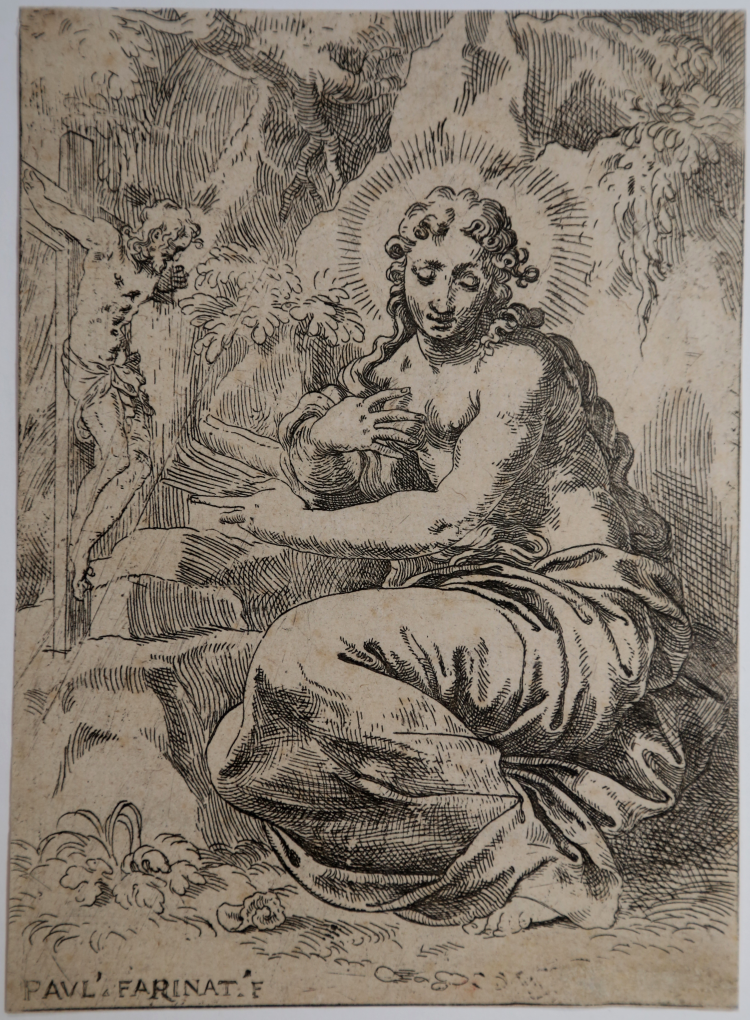




| Reference: | S32354 |
| Author | Paolo FARINATI |
| Year: | 1569 ca. |
| Measures: | 138 x 189 mm |



| Reference: | S32354 |
| Author | Paolo FARINATI |
| Year: | 1569 ca. |
| Measures: | 138 x 189 mm |
Etching and engraving, signed at bottom left PAUL’ FARINAT F.
Example in the third state of three.
A good impresison, printed on contemporary laid paper, trimmed to the platemark, in good condition.
Mary Magdalene in the desert seated before a cross at the left holding a book with her left hand, right on her breast.
The artist himself referred to this etching in his Diary. It had been considered as the iconographical model for a small painting in reverse, commissioned from the artist by Niccolo Troian in 1581, today in Narodní Galerie, Prague, inv. no. 814. According to Albricci 1980, the painting derives from a drawing, today lost, that was transformed into this etching at around the time of the painting's commission. Giorgio Marini argued that Farinati must have based his painting on a preparatory drawing rather than the print. The composition is close to Battista del Moro's painting of the same subject, included originally in the cicle of the Mantua cathedral, today in its sacristy.
|
Bartsch XVI.164.2; Albricci 19.2; Marini in Verona 2006, no. 193.
|
Paolo FARINATI (Verona 1524 - 1606)
|
Italian painter and draughtsman. He was the son of a painter, Giambattista, but probably trained in the workshop of Nicola Giolfino (Vasari). His earliest documented painting, St Martin and the Beggar (1552; Mantua Cathedral), was commissioned by Cardinal Ercole Gonzaga along with works by Battista dell’Angolo del Moro, Veronese and Domenico Brusasorci for Mantua Cathedral, newly restored by Giulio Romano. As is evident in his chiaroscuro and figure types, Farinati had absorbed certain Mannerist influences from the frescoes of scenes from the Life of the Virgin (1534) in the choir of Verona Cathedral, executed by Francesco Torbido to Giulio’s design. Giolfino’s eccentric style would also have encouraged Farinati to emphasize line over colour and to restrict his palette to rather opaque greys, browns, mauve and rust. His two-canvas Massacre of the Innocents (1556; Verona, S Maria in Organo) displays the muscular figures, sharp foreshortenings and posed attitudes of Mannerism and has a more polished finish than his earlier work. Its strong, plastic qualities are also evident in Christ Walking on the Water and the Supper of St Gregory (1558) in the choir of the same church. These characteristics are united with a more defined architectural space, derived from Veronese, in his Ecce homo (1562; Verona, Castelvecchio). In 1566 Farinati painted two frescoes—one of Elijah Ascending into Heaven, the other (damaged) of uncertain subject—on the walls flanking Veronese’s altarpiece in the Cappella Marogna, S Paolo, Verona. His use of somewhat brighter colours is probably due to the influence of Veronese. Farinati’s mythological and allegorical frescoes in the Palazzo Giuliari, Verona, were completed before he began his journal in 1573. Around 1575 he executed the cycle of canvases and frescoes depicting the Lives of SS Nazarius and Celsus in the choir of SS Nazaro e Celso, Verona. While his altarpiece of SS Francis and Nicholas (1588; Verona, S Paolo) is among the more colourful, his style did not change radically. His late works include the Miracle of the Loaves and Fishes (1603; Verona, S Giorgio in Braida). Drawings form a significant part of Farinati’s oeuvre, especially his numerous chiaroscuro drawings on tinted paper, which were often used as modelli (e.g. New York, Met.; Vienna, Albertina; Washington, DC, N.G.A.).
|
|
Bartsch XVI.164.2; Albricci 19.2; Marini in Verona 2006, no. 193.
|
Paolo FARINATI (Verona 1524 - 1606)
|
Italian painter and draughtsman. He was the son of a painter, Giambattista, but probably trained in the workshop of Nicola Giolfino (Vasari). His earliest documented painting, St Martin and the Beggar (1552; Mantua Cathedral), was commissioned by Cardinal Ercole Gonzaga along with works by Battista dell’Angolo del Moro, Veronese and Domenico Brusasorci for Mantua Cathedral, newly restored by Giulio Romano. As is evident in his chiaroscuro and figure types, Farinati had absorbed certain Mannerist influences from the frescoes of scenes from the Life of the Virgin (1534) in the choir of Verona Cathedral, executed by Francesco Torbido to Giulio’s design. Giolfino’s eccentric style would also have encouraged Farinati to emphasize line over colour and to restrict his palette to rather opaque greys, browns, mauve and rust. His two-canvas Massacre of the Innocents (1556; Verona, S Maria in Organo) displays the muscular figures, sharp foreshortenings and posed attitudes of Mannerism and has a more polished finish than his earlier work. Its strong, plastic qualities are also evident in Christ Walking on the Water and the Supper of St Gregory (1558) in the choir of the same church. These characteristics are united with a more defined architectural space, derived from Veronese, in his Ecce homo (1562; Verona, Castelvecchio). In 1566 Farinati painted two frescoes—one of Elijah Ascending into Heaven, the other (damaged) of uncertain subject—on the walls flanking Veronese’s altarpiece in the Cappella Marogna, S Paolo, Verona. His use of somewhat brighter colours is probably due to the influence of Veronese. Farinati’s mythological and allegorical frescoes in the Palazzo Giuliari, Verona, were completed before he began his journal in 1573. Around 1575 he executed the cycle of canvases and frescoes depicting the Lives of SS Nazarius and Celsus in the choir of SS Nazaro e Celso, Verona. While his altarpiece of SS Francis and Nicholas (1588; Verona, S Paolo) is among the more colourful, his style did not change radically. His late works include the Miracle of the Loaves and Fishes (1603; Verona, S Giorgio in Braida). Drawings form a significant part of Farinati’s oeuvre, especially his numerous chiaroscuro drawings on tinted paper, which were often used as modelli (e.g. New York, Met.; Vienna, Albertina; Washington, DC, N.G.A.).
|